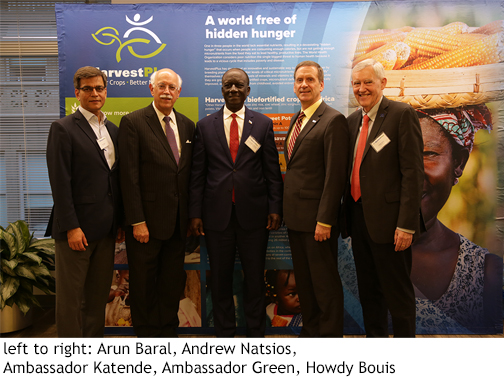Partners, funders, and stakeholders of HarvestPlus gathered at a reception this week to welcome the global program’s new leadership and tour several interactive stations that showed how HarvestPlus addresses hidden hunger with nutritious biofortified crops.
The attendees included Mark Green, the Administrator of the United States Agency for International Development (USAID), as well as two former USAID administrators: Andrew Natsios, who is the current chair of the HarvestPlus Program Advisory Committee (PAC), and Peter McPherson, who is also Natsios’ predecessor as PAC chair. Also participating were Greg Collins, Deputy Assistant Administrator in the USAID Bureau for Food Security, and the Ambassador of Uganda to the United States, His Excellency Mull Sebujja Katenda. The reception was held at the International Food Policy Research Institute (IFPRI), where HarvestPlus has its headquarters.
Natsios, who led USAID from 2001 to 2006 and became chair of the HarvestPlus PAC earlier this year, said his interest in the HarvestPlus role was firmly rooted in his witnessing firsthand how micronutrient deficiency is “causing profound health and educational problems in the developing world.” He added: “The more I read the literature [about biofortification], the more persuaded I was that it could have a profound impact” on this global problem.
Natsios said that the focus of HarvestPlus and its partners now is to make biofortification sustainable and scalable. “Our job now is to get it into the markets—that’s the way to make sustainable,” he said.
HarvestPlus leads a global movement to address micronutrient deficiency (or hidden hunger) by developing and delivering staple food crops that are conventionally bred to be rich in essential vitamins and minerals—a process known as biofortification. Hidden hunger affects more than 2 billion people worldwide, primarily in low- and middle-income countries, making them vulnerable to stunting, anemia, impaired vision, and many other serious health problems.
Baral, who took over as CEO of the program in July from founder Howarth “Howdy” Bouis, spent more than 30 years in the global agriculture sector prior to joining HarvestPlus as Chief Financial Officer in 2017. At the reception, Baral told attendees about a time when he was in Uganda and visited a school where children were being served a porridge that provided a vitamin A boost. The children were jostling to get the porridge, and he asked what excited them about it. “I can see better. I can read better. My grades are up,” was the reply.
Baral said the experience was one of many during his stint in the private sector that highlighted for him the critical need to ensure that children, their mothers, and their whole families get the nutrients they need for good health. “We’ve got 2 billion people that we’re trying to help and improve these people’s lives,” he said. “Our objective by 2030 is to reach at least 1 billion of them with biofortified crops and foods.” HarvestPlus focuses on development and delivery of eight biofortified varieties of widely consumed staples: iron beans and pearl millet; zinc maize, rice, and wheat; and vitamin A cassava, maize, and orange sweet potato.
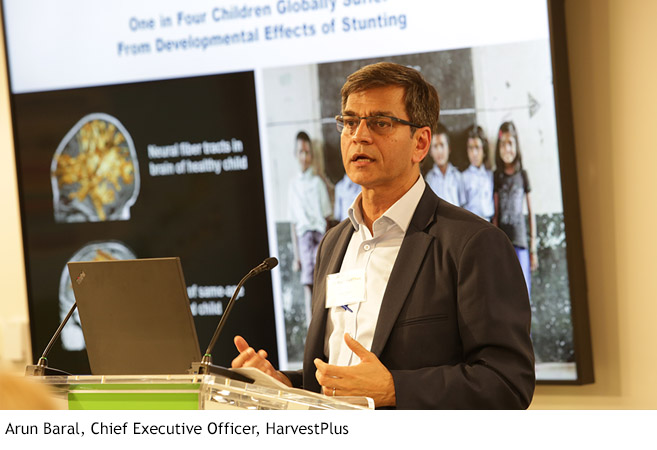
Regarding Uganda, Ambassador Katende thanked USAID for its ongoing funding to develop and deliver HarvestPlus iron beans and vitamin A sweet potato, noting that the HarvestPlus project is “is a fine example of our productive collaboration with the U.S.A.” One sign of Uganda’s leadership on biofortification, he noted, was that President Yoweri Museveni was present at the launch of the first iron beans in 2017 and that Uganda was a pioneer in efforts to scale up biofortification.
Collins of USAID praised the clear vision of HarvestPlus to make nutrition and agriculture work together to solve serious health problems. “This is an incredible accomplishment,” he said, adding that USAID was encouraged by the important role of the private sector in plans to bring biofortification to scale. “This is the road to sustainability,” he noted. HarvestPlus founder and World Food Prize laureate Dr. Howdy Bouis thanked USAID for its early and ongoing support for biofortification.
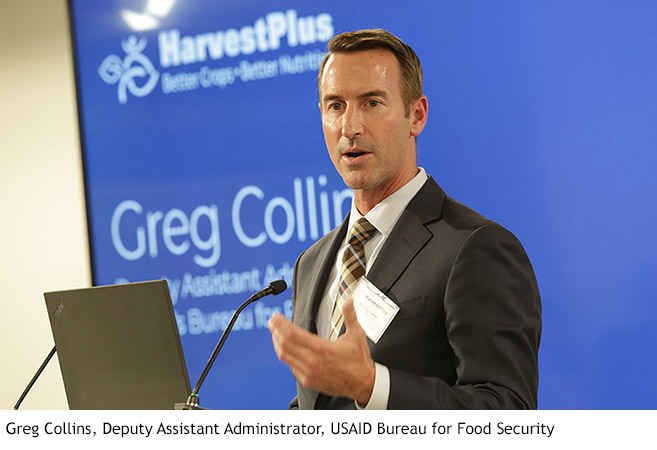
At interactive stations that highlighted HarvestPlus’ regional and technical work, visitors saw and experienced how HarvestPlus and its many partners around the world make biofortified seeds and foods available to farmers and consumers in Africa, Asia, and Latin America. For example, at a station focusing on our work in Africa, HarvestPlus Nigeria Country Manager Paul Ilona showed Ambassador Green various food products made from biofortified crops, such as fufu, a common starchy food made from pounded cassava. In Nigeria, HarvestPlus promotes cassava and maize, both biofortified with vitamin A.
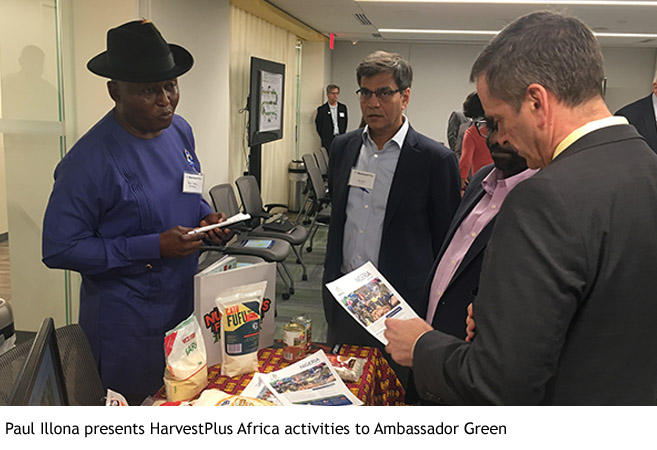
At another station, Ambassador Katende was able to view a range of food products made with biofortified crop ingredients. Jenny Walton, a HarvestPlus staff member who develops partnerships with food companies, explained how we provide assistance in sourcing biofortified ingredients and strategies for marketing biofortified food products to consumers.
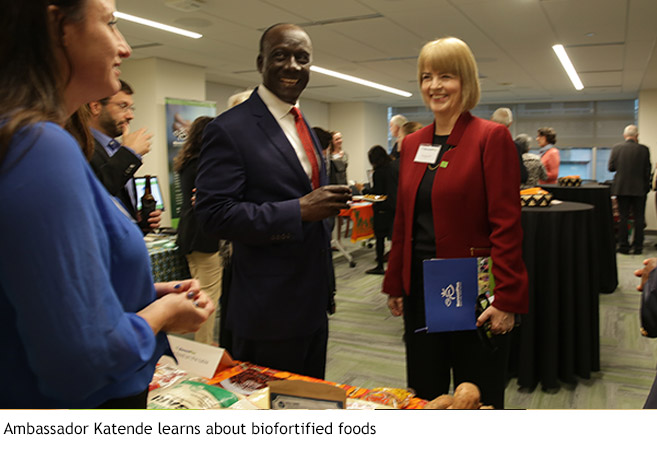
The biofortified crops promoted by HarvestPlus currently reach nearly 40 million people living on smallholder farms in Africa, Asia, and Latin America. These low-resource individuals are at high risk of experiencing hidden hunger. In addition to reaching these smallholder families, HarvestPlus also actively works with hundreds of partners to build out sustainable biofortified food systems that also reach urban and other nonfarm consumers.
HarvestPlus was founded in 2003 and has so far facilitated the release of more than 200 varieties of biofortified crops in 30 countries. The program is supported by a robust body of evidence that vitamins or minerals from biofortified foods make a difference in nutrition and health.
